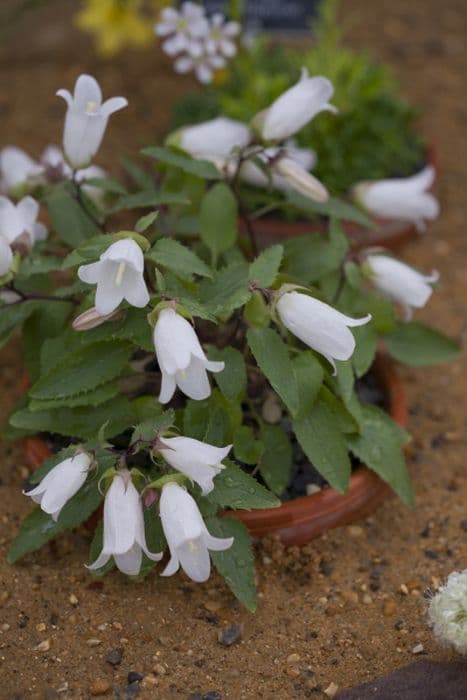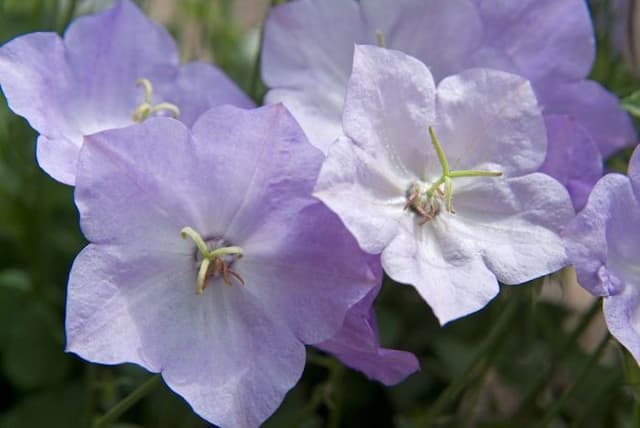Campanula glomerata 'Caroline'

ABOUT
The plant known as Caroline clustered bellflower is a charming perennial with a characteristic appearance. It displays an array of vivid, bell-shaped flowers, which exhibit a delightful shade of purple. These blossoms tend to congregate closely together, forming dense clusters that provide a striking visual impact. The flowers sit atop sturdy stems that rise up from the plant’s base. The foliage of the clustered bellflower 'Caroline' is bright green, forming a lush backdrop that contrasts beautifully with the purple flowers. The leaves are largely shaped like ovals with pointed tips, and they often have slightly toothed edges. The combination of its lovely flowers and attractive leafage makes Caroline clustered bellflower a popular choice for adding a pop of color and texture to garden beds and borders. Overall, this plant exudes a sense of cottage charm and can be a showstopper in any garden during its blooming period. It is appreciated for its ability to attract pollinators like bees and butterflies, adding not only beauty but also contributing to the biodiversity of the garden space.
About this plant
 Names
NamesFamily
Campanulaceae.
Synonyms
Clustered Bellflower, Dane's Blood, Caroline Clustered Bellflower.
Common names
Campanula glomerata 'Caroline'.
 Toxicity
ToxicityTo humans
Clustered Bellflower is generally considered non-toxic to humans. There are no well-documented cases of poisoning from ingesting this plant. Nevertheless, individuals might be allergic or sensitive to different plant species, and it is always a good practice to avoid eating plants that are not known to be edible.
To pets
Clustered Bellflower is also not known to be toxic to pets. It is not listed among the common toxic plants for animals such as cats and dogs. However, individual animals may react differently to certain plants, and ingestion should still be discouraged to prevent potential gastrointestinal upset or an unexpected allergic reaction.
 Characteristics
CharacteristicsLife cycle
Perennials
Foliage type
Deciduous
Color of leaves
Green
Flower color
Lavender
Height
1-2 feet (30-60 cm)
Spread
1-2 feet (30-60 cm)
Plant type
Herb
Hardiness zones
3-8
Native area
Europe
Benefits
 General Benefits
General Benefits- Attracts Pollinators: Campanula glomerata 'Caroline', commonly known as Clustered Bellflower, is known for its ability to attract bees, butterflies, and other beneficial insects to the garden.
- Aesthetic Appeal: This perennial offers a beautiful display of violet-purple flowers that add color and visual interest to any garden space.
- Drought Tolerance: Once established, Clustered Bellflower can tolerate periods of drought, making it a suitable choice for water-wise landscapes.
- Low Maintenance: It requires minimal care once established, making it ideal for gardeners who prefer low-maintenance plants.
- Frost Hardy: Clustered Bellflower is capable of withstanding cold temperatures, making it suitable for a variety of climates.
- Wildlife Habitat: Provides shelter and nesting opportunities for small wildlife in the garden.
- Cut Flowers: The flowers of Campanula glomerata 'Caroline' are suitable for cutting and can be used in floral arrangements.
- Ground Cover: When planted in groups, it can serve as an effective ground cover, suppressing weeds and covering bare spots in the landscape.
- Edging Plant: Due to its compact size, it can be used to define garden borders and edges.
 Medical Properties
Medical PropertiesThis plant is not used for medical purposes.
 Air-purifying Qualities
Air-purifying QualitiesThis plant is not specifically known for air purifying qualities.
 Other Uses
Other Uses- Edible Flowers: Clustered Bellflower's blooms can be used in salads or as garnishes for a delicate, floral touch in various dishes.
- Photography Subject: Due to its vibrant blue-violet flowers, this plant is often utilized by photographers looking for colorful, natural subjects.
- Art Inspirations: Artists may use Clustered Bellflower as an inspiring subject for botanical paintings and drawings.
- Dye Production: Historically, the flowers of Clustered Bellflower might have been used to produce a natural dye for fabrics.
- Culinary Decoration: The flowers can be crystallized with egg white and sugar to create an elegant cake decoration.
- Insect Attractant: This plant is helpful in gardens for attracting bees and other beneficial pollinators.
- Education Tool: Clustered Bellflower can be used in educational settings to teach about plant anatomy and pollination.
- Fairy Gardens: Due to its quaint and charming appearance, it is a popular choice for inclusion in magical-themed or fairy gardens.
- Floral Arrangement: The flowers and foliage of Clustered Bellflower can add interesting texture and color to cut flower arrangements.
- Seed Crafting: The seeds of Clustered Bellflower can be used in seed art or mixed-media artwork for their shape and texture.
Interesting Facts
 Feng Shui
Feng ShuiThe Clustered Bellflower is not used in Feng Shui practice.
 Zodiac Sign Compitability
Zodiac Sign CompitabilityThe Clustered Bellflower is not used in astrology practice.
 Plant Symbolism
Plant Symbolism- Gratitude - The bell-shaped blossoms of the Clustered Bellflower often symbolize a sense of thankfulness, possibly due to the way the blooms seem to nod or bow in the garden.
- Constancy - A common trait attributed to bellflowers in general, it reflects the plant’s reliable and perennial nature, as the Clustered Bellflower comes back year after year.
- Humility - The downward facing flowers can be seen as a gesture of humility, making the Clustered Bellflower a symbol of modesty.
- Unwavering Love - In the language of flowers, bell-shaped blossoms are often associated with unwavering love, suggesting a steadfast and enduring affection.
- Versatility - Campanula species have a wide range of uses in gardens and can thrive in various conditions, reflecting the idea of versatility and adaptability.
 Water
WaterClustered Bellflower (Campanula glomerata 'Caroline') thrives when the soil is kept evenly moist but not soggy. As a general rule, water the plant once a week with about one inch of water, allowing the top inch of soil to dry out between waterings. During periods of extreme heat or drought, watering frequency should increase to twice a week. Be cautious not to overwater, as this can lead to root rot. It's best to water the plant in the morning to allow for moisture to be absorbed throughout the day and to prevent fungal diseases often associated with night watering.
 Light
LightClustered Bellflower prefers a spot that receives full sun to partial shade. Ideally, position it to get at least 6 hours of sunlight daily, which promotes robust growth and abundant flowering. However, in regions with very hot summers, it benefits from some afternoon shade to prevent stress from intense midday sun.
 Temperature
TemperatureClustered Bellflower is hardy and can tolerate a temperature range from around 40 to 85 °F. It can survive brief periods of colder temperatures down to about 20 °F, but prolonged exposure can harm the plant. The ideal growing temperatures are between 60 and 70 °F, which enables good growth and flowering.
 Pruning
PruningPrune your Clustered Bellflower after the first flush of blooming to encourage a second bloom period. Cut back the spent flower stems to the base of the plant. Pruning should be done annually, typically in late summer or early fall, after flowering has ceased. This helps to maintain the plant's shape, remove any dead or damaged foliage, and promote overall plant health.
 Cleaning
CleaningAs needed
 Soil
SoilClustered Bellflower thrives in well-draining soil with a pH range from neutral to slightly alkaline, about 6.0 to 8.0. A soil mix consisting of garden soil, peat, and perlite or sand in equal parts will ensure good drainage and aeration, which is ideal for the Clustered Bellflower.
 Repotting
RepottingClustered Bellflower, or Caroline, generally doesn't require frequent repotting and should be repotted only when it has outgrown its current container, typically every 2-3 years.
 Humidity & Misting
Humidity & MistingClustered Bellflower, or Caroline, is adaptable to a wide range of humidity levels and does not have specific humidity requirements, making it versatile for various environments.
 Suitable locations
Suitable locationsIndoor
Place in bright, indirect light and keep soil moist.
Outdoor
Full sun to part shade in well-draining soil.
Hardiness zone
3-8 USDA
 Life cycle
Life cycleThe life of Campanula glomerata 'Caroline', also known as clustered bellflower, commences with seed germination, typically in early spring, when temperatures are mild and moist conditions support growth. Seedlings emerge and form a basal rosette of leaves as they mature. From the rosette, erect stems develop and the plant enters the vegetative growth stage, during which it focuses on leaf and stem production. As summer approaches, the clustered bellflower transitions into the flowering stage, producing dense clusters of vibrant blue-violet flowers at the stem tips that attract various pollinators. After pollination, the flowers develop into seed capsules, and by late summer or early autumn, the plant sets seeds which are then dispersed by wind, gravity, or animal movement. The plant typically dies back in winter, especially in colder climates, to re-emerge from overwintering root stock or self-sown seeds the following spring.
 Propogation
PropogationPropogation time
Late spring to early summer
The Campanula glomerata 'Caroline', commonly known as Clustered Bellflower 'Caroline', is often propagated by division, which is a popular and effective method for this perennial plant. Division should ideally take place in the spring or early fall, when the plant is not in active bloom. To propagate by division, carefully lift the plant from the ground with a shovel or garden fork, ensuring you get as much of the root system as possible. Gently tease apart the plant into smaller sections, making sure each section has a healthy portion of roots attached. Replant these divisions immediately in well-prepared soil, spacing them about a foot (approximately 30cm) apart to allow room for growth. Water the new plantings thoroughly to help establish them. This method allows gardeners to quickly and effectively propagate the Clustered Bellflower 'Caroline', while also rejuvenating older plants that may have become too large or crowded.








![Milky bellflower [Avalanche]](/_next/image?url=https%3A%2F%2Fplants-admin.emdemapps.com%2Fimages%2Fplants%2F%2Fimages%2F604b5dc88c1e7.png&w=640&q=75)
